If there’s any positive fallout from the U.S. threat to annex Canada, it’s the kick-started patriotism now revving up here. With Greenland also in Donald Trump’s sights, similar rallying around national identity is playing out in the Arctic Circle, one of the most remote regions on the planet.
This was brought home Friday during the outcry around the unwelcome visit to Greenland by a group of American delegates, among them Vice President JD Vance and the second lady. Having already hit back at Trump earlier asserting that Greenlanders “do not wish to be Americans,” the island’s prime minister, Mute Egede, stated that he found Trump’s decision to send representatives on Mar. 28 “highly aggressive.”
The American group initially had a full itinerary which included attending the national dogsled race. However, evidently, due to scheduling and protest concerns, this was scaled back to a visit to the U.S. military base.
While there, Vance slammed Greenland’s current governance and stated, “We think we’re going to be able to cut a deal, Donald Trump style, to ensure the security of this territory.”
Greenland’s strategic value and resource wealth
It’s no secret that it’s not just national security interests fuelling Trump’s Greenland agenda. Like other superpowers including China and Russia, he also has his eyes on the island territory’s mineral resources, lying untapped under its vast, thawing ice sheet three times the size of Alberta. Not to be overlooked either are the prospective international shipping channels emerging from deep freeze due to global warming.
Climate change could be making Greenland—and Canada—hot commodities.
According to Greenland real estate broker Miki Lynge, located in the capital city of Nuuk, where one-third of the population resides, “there’s never been so many foreign media here.” In his observation, the current situation has made some people “a little hesitant” to buy.
“The real estate market is relatively new here,” Lynge notes. With rental housing previously largely provided by the public sector, “it’s only about two or three generations that have had their own house or apartment.”
Understanding Greenland’s unique property market
You can’t own land there, but you can own the house sitting on it, explains Anna Jensine Arntzen, a Scandinavian PhD student studying urban planning in Greenland. “You have to apply to the government for site allocation.”
On the plus side, with no land rights, there’s no property tax.
While geographically part of North America, Greenland is a semiautonomous territory of Denmark. ‘It’s complicated’ would be an apt way to describe their relationship. Greenland’s economy is heavily reliant on fisheries and aid from Denmark. Greenlanders—a blending of traditional Inuit and Danish—have a powerful national identity and have been pushing toward gradual full independence. A staunch pro-independence political party favouring greater cooperation with the U.S. was shut out of a new government coalition agreement on the day of the American delegation’s arrival.
Fascinating facts about Greenland
A few mind-blowing facts about this Arctic island overhung with dazzling curtains of Northern Lights:
It’s the largest island in the world. (Australia is four times bigger but is classified as a continent.)
Only 20 per cent of Greenland is inhabited. With a mere 57,000 people, scattered almost exclusively along its fiord-riddled southwest coast, the entire population could fit into a large sports stadium.
Keeping the sled dog population pristine is considered so essential that having a pet dog is illegal in much of Greenland. More people own boats than cars. The terrain is so rugged that there’s no road network connecting different communities. If you own a car, you’re only driving it in your own town. All roads stop on the outskirts.
Greenland is socially progressive. Education and healthcare are free. LGBTQ rights are among the most extensive anywhere. It has the highest suicide rate in the world, as well as a high rate of alcoholism. In winter, it’s dark 24/7.
Trump’s previous attempts and market implications
Back to Trump—this isn’t the first time he’s made a play for Greenland. His initial attempt in 2019 during his first term in office was equally poorly received. Nevertheless, he told journalists that it would be a great real estate deal that would secure his place in history.
The spotlight thrown on Greenland back then gave its property market a boost. Despite all the attention, there hasn’t been a market uptick this time around. New laws restricting foreign ownership implemented this past February due to geopolitical concerns may be to blame.
Experts observe that Greenland is shifting towards sustainability, embracing green technologies, and positioning itself as a pioneer in eco-friendly real estate.
Real estate challenges and opportunities in Nuuk
Nevertheless even in Nuuk—with its street art, multi-storey housing blocks, and brightly-painted wooden houses nestled into a mountainside—there are less than a handful of real estate agencies (none of them North American brands), observes Carina Serano, an agent with the Netbolig Brokerage there.
“We’re quite busy, and growing,” she says. “I think the biggest issue facing the market is that the government is closing off purchases for foreigners.”
Many Greenlanders tend to move every few years, continues Serano. Being so remote, the cost of living in Greenland is high, and some would say it is astronomical. The standard of living is reasonable but depopulation is on the rise. The U.S. has reportedly made comments about infrastructure there falling into disrepair.
Housing prices are dependent on location, with homes and apartments in bigger centres like Nuuk, Sisimiut and Ilulissat potentially being comparable or even more pricey than in Canada, due to factors such as high import costs and limited infrastructure. Housing in small settlements, though, can be much more affordable.
Navigating a unique real estate landscape
In Greenland’s real estate industry, “regulations are few,” according to Serano. “So as much as we can, we like to follow Denmark.” Real estate training in Greenland is available, but she got her education and license in Denmark, follows Danish systems regarding transactions where possible, and belongs to the pertinent Danish associations. Advertising is largely done online—via websites and social media.
There are some “big holes” though, she notes. No MLS database. No digitized documents. Financing can be challenging for those who don’t live in the smattering of larger towns, and property registrations in far-flung settlements are occasionally not up to date.
On the plus side, there are minimal taxes and few competitors, Serano asserts. “It’s quite comfortable.” She is paid a decent commission by sellers, also receives a salary, and maintains that she earns an amount annually that puts her in a top income bracket.
Now it looks as if the world’s biggest island will be a key player in the battle gearing up over control of the Arctic. One thing seems clear—neither Greenland nor Canada wants any part of being the 51st state.
Susan Doran is a Toronto-based freelance writer who has been contributing to REM since its very first issue.















